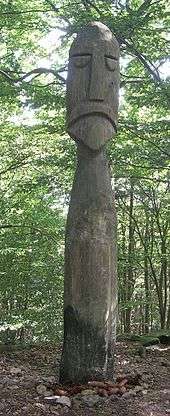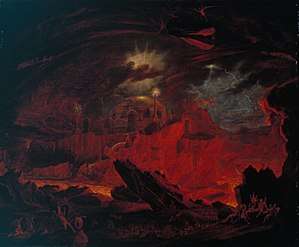Veles (god)
Veles (Cyrillic Bulgarian, Macedonian, Serbian and Ukrainian: Велес; Polish: Weles; Bosnian, Croatian, Czech, Montenegrin, Slovak, Slovenian: Veles; Ruthenian and Old Church Slavonic: Велесъ; Belarusian: Вялес, romanized: Vialies), also known as Volos (Russian: Волос, Влас, Власий listed as a Christian saint, Armenian: Սուրբ Վլասի; germ: Blasius; fr: Blaise; sp: San Blas; port: São Brás; it: San Biagio; croat: sv. Blaž; eng: Blase, Wallace; Greek: Άγιος Βλάσιος), is a major Slavic god of earth, waters, and the underworld. His attributes are wet, wooly, hairy (bearded), dark and he is associated with cattle, the harvest, wealth, music, magic, and trickery. According to reconstruction by some researchers, he is the opponent of the supreme thunder god Perun.[2]:211–214 As such he probably has been imagined as a dragon, which in the belief of the pagan Slavs is a chimeric being, a serpent with a bear's head and drooping hairy ears.[2]:141[3]:87,88 His tree is the willow much like Perun's tree is the oak. No direct accounts survive, but reconstructions speculate that he may directly continue aspects of the Proto-Indo-European pantheon.
| Veles | |
|---|---|
underworld, earth, waters, trickery, cattle, snakes, bears, wolves, music, and magic | |
 Veles, Marek Hapon, 2014 | |
| Symbol | Bear, wolf, snake, dragon, owl, willow |
| Festivals | The Festival of Veles |

Sources
Veles is one of few Slavic gods for which evidence of offerings can be found in all Slavic nations. The Primary Chronicle, a historical record of the early Kievan Rus, is the earliest and most important record, mentioning a god named Volos several times. Here, Volos is mentioned as god of cattle and peasants, who will punish oath-breakers with diseases, the opposite of Perun who is described as a ruling god of war who punishes by death in battle. In the later half of the 10th century, Veles or Volos was one of seven gods whose statues Vladimir I of Kiev had erected in his city. It is very interesting that Veles' statue apparently did not stand next to others, on the hill where the prince's castle was, but lower in the city, in the marketplace. Not only does this indicate that Veles was connected with commerce, but it also shows that worship of Perun and Veles had to be kept separate: while it was proper for Perun's shrines to be built high, on the top of the hill, Veles' place was down, in the lowlands.
A similar pattern can be observed among the South Slavs. Here the name of Veles appears only in toponyms, the best-known of which is the city of Veles in Macedonia, over which looms a hill of St. Elias the Thunderer. Also, in Bosnia and Herzegovina, a part of Sarajevo is called Velešići[4] and a mountain Velež[5] near Mostar, Herzegovina. Other examples are Veles in Western Serbia, Velesnica on the Danube and Velestovo in Montenegro and also the township of Velestino (Βελεστίνο, today Φέρες), apparently bearing testimony to a Slavic layer in the settlement of Thessaly. Another debatable if not improbable example[2]:178 is the town of Volosko in Croatia, situated on the seashore under the peak of Mount Učka, nicknamed Perun.
Among Western Slavs, the name can be principally found in 15th and 16th century Czech records, where it means either dragon or devil.
Etymology
_(14578796339).jpg)
Presumably it is not possible to conclusively determine a definite etymology for the name of the god Veles, though there are several Proto-Indo-European roots that are all closely related to the nature of Veles and his domains.
One possibility is that the name derives from the Proto-Indo-European root *wel-, meaning wool.[6] This seems plausible, since in Slavic cosmology Veles in serpentine form is lying in a nest of black wool in the roots of the Tree of the World[2]:136,154 and Veles is the shepherd of the dead. Volos is also the Russian and Ukrainian word for "hair" and Veles is hairy in his beastly form (bear, wolf).
The Proto-Indo-European root *welg- also means humid, wet. Nothing is more connected with Veles than humidity and wetness. His domain is down, 'у воду пот корч пот колоду' (in the water, below the tree stump and the log).
There is also the Indo-European word *woltus meaning meadow which is derived from the same root. And Veles is the shepherd of the dead who was imagined to browse the deceased on green lush meadows in the underworld.[2]:171[7]
The name is also related to Slavic terminology for oxen, for which the South Slavs, Russians, and Poles use "вол/vol/wół". Volos can also be a derivation from the same root by Eastern Slavic phonetic laws, now considered the most probable explanation for this phonetic form.[2]:171
It is probably the same as Vala, the enemy of the Vedic thunder god Indra and to Velns (Latvian) or Vėlinas (Lithuanian), a devil of Baltic mythology and enemy of the Baltic thunder-god Perkūnas (cf. Slavic Perun).
Enemy of Perun and storm myth
The Russian philologists Vyacheslav Ivanov and Vladimir Toporov reconstructed the mythical battle of Perun and Veles through comparative study of various Indo-European mythologies and a large number of Slavic folk stories and songs. A unifying characteristic of all Indo-European mythologies is a story about a battle between a god of thunder and a huge serpent or a dragon. In the Slavic version of the myth, Perun is a god of thunder while Veles acts as a dragon who opposes him, consistent with the Vala etymology; he is also similar to the Etruscan underworld monster Vetha and to the dragon Illuyankas, enemy of the storm god of Hittite mythology.
The reason for the enmity between the two gods is Veles's theft of Perun's son, wife, or, usually, cattle. It is also an act of challenge: Veles, in the form of a huge serpent, slithers from the caves of the underworld and coils upwards the Slavic world tree towards Perun's heavenly domain. Perun retaliates and attacks Veles with his lightning bolts. Veles flees, hiding or transforming himself into trees, animals or people. In the end, he is killed by Perun and in this ritual death, whatever Veles stole is released from his battered body in the form of rain falling from the skies. This "storm myth", or "divine battle", as it is generally called by scholars today, explained to ancient Slavs the changing of seasons through the year. The dry periods were interpreted as the chaotic results of Veles' thievery. Storms and lightning were seen as divine battles. The ensuing rain was the triumph of Perun over Veles and the re-establishment of world order. On a deeper level, as has been said above, Perun's place is up, high and dry and Veles' down, low and wet. By climbing up into the sphere of Perun, Veles disrupts the equilibrium of the world and needs to be put in his place. Perun does this in a fierce battle by smiting him with his lightning and drives him down into the water under the tree stub and the log and by putting him back in his place Perun restores order. Then they stop being adversaries and remain just opponents until the next time Veles tries to crawl up into Perun's realm.
The myth was cyclical, repeating itself each year. The death of Veles was never permanent; he would reform himself as a serpent who would shed its old skin and would be reborn in a new body. Although in this particular myth he plays a negative role as bringer of chaos, Veles was not seen as an evil god by ancient Slavs. In fact, in many of the Russian folk tales, Veles, appearing under the Christian guise of St. Nicholas, saves the poor farmer and his cattle from the furious and destructive St. Elias the Thunderer, who represents Perun.[lower-alpha 1] The duality and conflict of Perun and Veles does not represent the dualistic clash of good and evil; rather, it is the opposition of the natural principles of earth and water (Veles) against heaven/sky and fire (Perun).
The Ivanov/Toporov conception of "the key myth" of Slavic mythology has been criticized by several authors, including Leo Klejn[8] and Igor M. Diakonoff.[9] Many, including Klejn, pointed out that Ivanov and Toporov often tended toward unjustified generalizations and considered many of their arguments "far-fetched". Supporters of the theory, on the other hand, include Boris Uspensky, T. Sudnik and T. Tsivyan, and others.
God of magic and musicians
According to Ivanov and Toporov, Veles' portrayal as having a penchant for mischief is evident both from his role in the storm myth and in carnival customs of Koledari shamans. In his role as a trickster god, he is in some ways similar to both Greek Hermes and Scandinavian Loki. He was connected with magic. The word volhov, obviously derived from his name, in some Slavic languages still means sorcerer while in the 12th century Ruthenian epic The Tale of Igor's Campaign, the character of Boyan the wizard is called Veles' grandson. Veles was also believed to be protector of travelling musicians. For instance, in some wedding ceremonies of northern Croatia (which continued up to the 20th century), the music would not start playing unless the bridegroom, when making a toast, spilled some of the wine on the ground, preferably over the roots of the nearest tree. The symbolism of this is clear, even though forgotten long ago by those still performing it: the musicians will not sing until a toast is made to their patron deity.[6]
Post-Christian Veles
After the advent of Christianity, Veles was split into several different characters. As a god of the underworld and dragons, he, of course, became identified with the Devil. His more benevolent sides were transformed to several Christian saints. As a protector of cattle, he became associated with Saint Blaise, popularly known among various Slavic nations as St. Vlaho, St. Blaz, or St. Vlasiy. In Yaroslavl, for example, the first church built on the site of Veles's pagan shrine was dedicated to St Blaise, for the latter's name was similar to Veles and he was likewise considered a heavenly patron of shepherds.[10] As mentioned already, in many Eastern Slavic folk tales, he was replaced by St. Nicholas, probably because the popular stories of the saint describe him as a giver of wealth and a sort of a trickster.
Honors
Veles Bastion on Brabant Island, Antarctica is named after the deity.[11]
See also
- Chaoskampf, the battle between Indo-European thunder gods and their chaotic serpentine opponents
- Golosov Ravine—ancient Veles shrine in Moscow, Russia
- Jormungandr, the world-serpent of Norse mythology
- Typhon, primordial serpent of Greco-Roman mythology
- Velež Mountain in Herzegovina
- Vritra, brother of Vala in Hindu myth and enemy of Indra; he steals Usas, the rivers/waters, and cattle, which Indra must free
- Veles, North Macedonia, a town in North Macedonia
- Velestovo, a village in Montenegro
Notes
- On rudiments of pagan cults in Slavic folk Christianity see: (Успенский 1982)
References
- Aleksandra Kojic (2016-08-18). "Veles – The Slavic Shapeshifting God of Land, Water and Underground". Slavorum. Retrieved 2017-09-08.
- Katičić, Radoslav (2008). Božanski boj: Tragovima svetih pjesama naše pretkršćanske starine (PDF). Zagreb: IBIS GRAFIKA. ISBN 978-953-6927-41-8. Archived from the original (PDF) on 2015-10-18.
- Успенский, Борис Александрович (1982). Филологические разыскания в области славянских древностей. Реликты язычества в восточнославянском культе Николая Мириликийского. Moscow State University.
- "OPIS LOKACIJE MZ UNUTAR OPĆINE". Archived from the original on March 8, 2005. Retrieved September 12, 2012.
- Velež (Bosnia and Herzegovina)
- Vitomir Belaj "Hod kroz godinu, mitska pozadina hrvatskih narodnih vjerovanja i obicaja", Golden Marketing, Zagreb 1998., ISBN 953-6168-43-X
- Ivanov, Vyacheslav; Toporov, Vladimir (1973). "A comparative study of the group of Baltic mythological terms from the root *vel-". baltistica T.9 Nr.(1). Cite journal requires
|journal=(help) - Клейн Л. С. Воскрешение Перуна. К реконструкции восточнославянского язычества. — Saint Petersburg: Евразия, 2004.
- Дьяконов И. М. Архаические мифы Востока и Запада. Nauka, 1990
- Boris Rybakov. Ancient Slavic Paganism. Moscow, 1981
- Veles Bastion. SCAR Composite Antarctic Gazetteer


